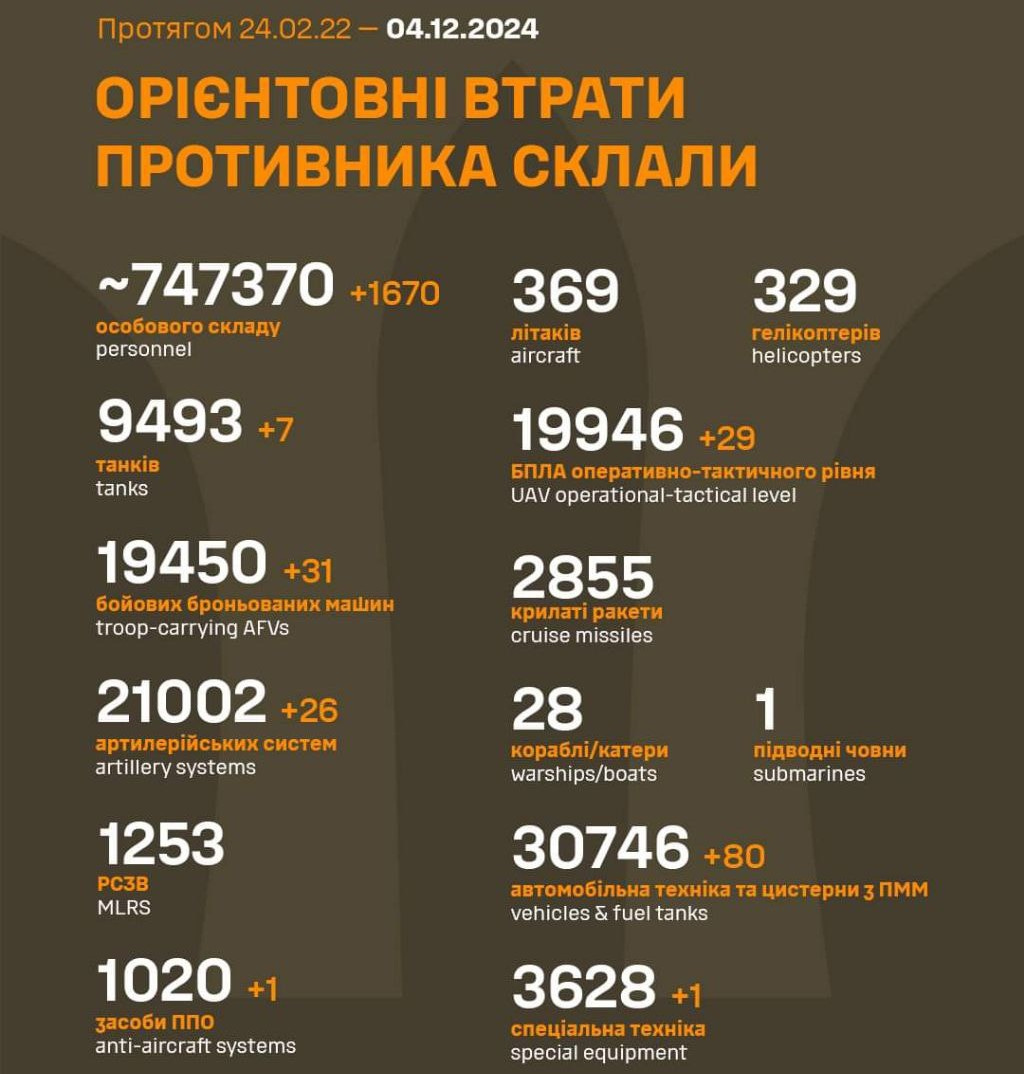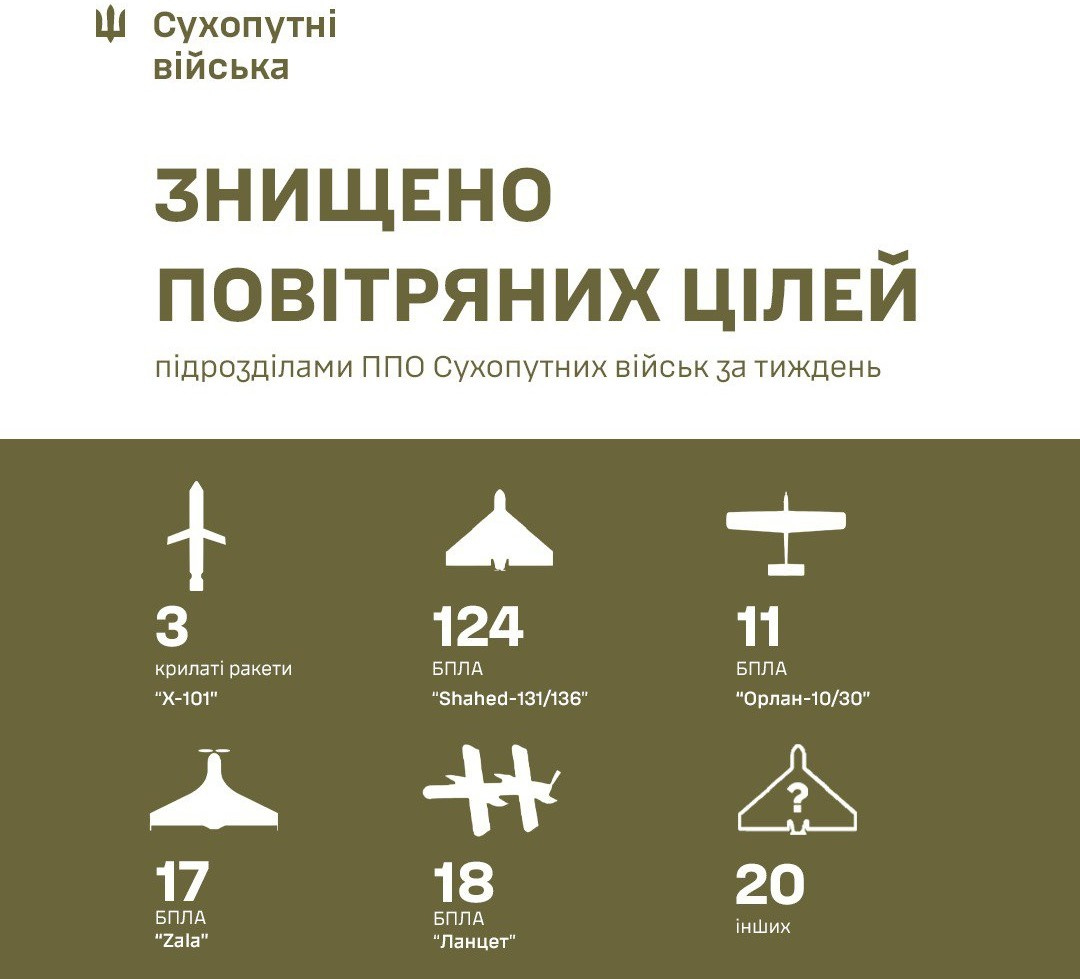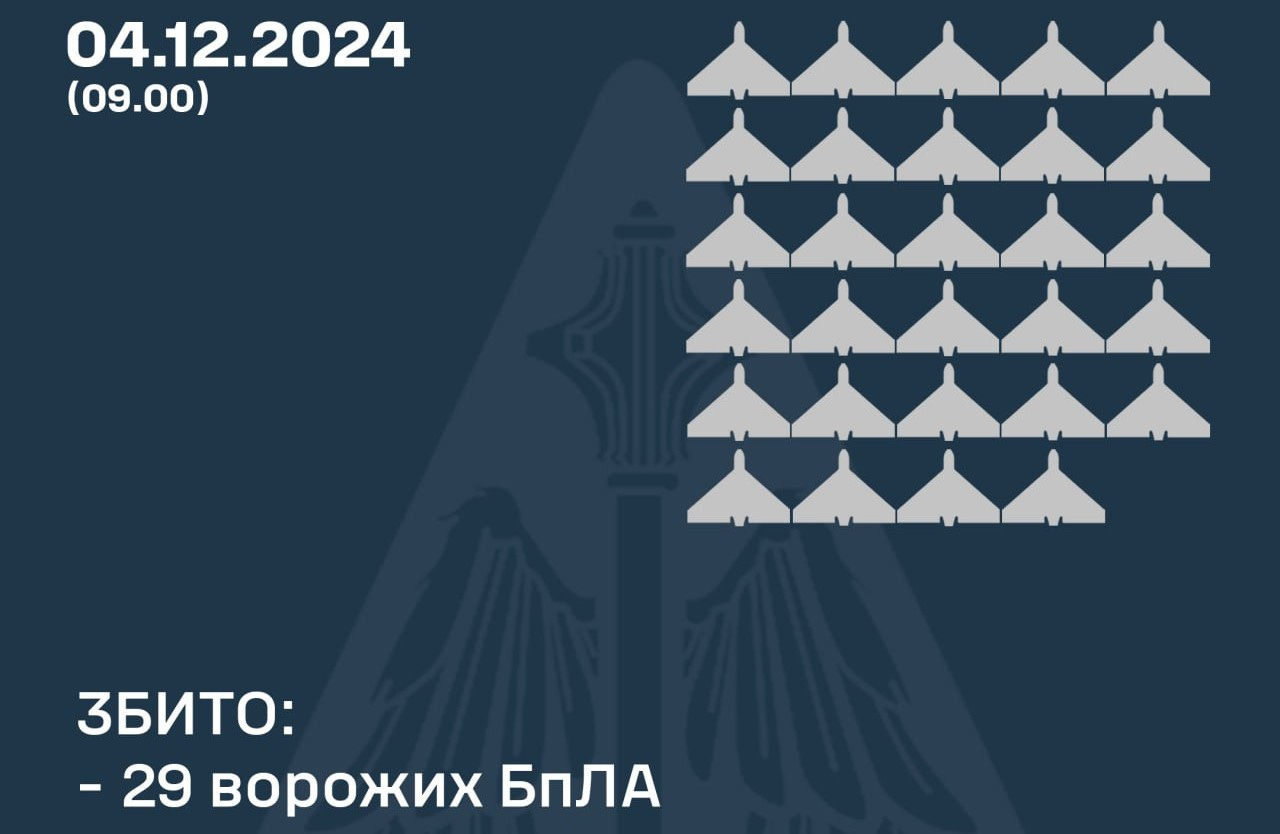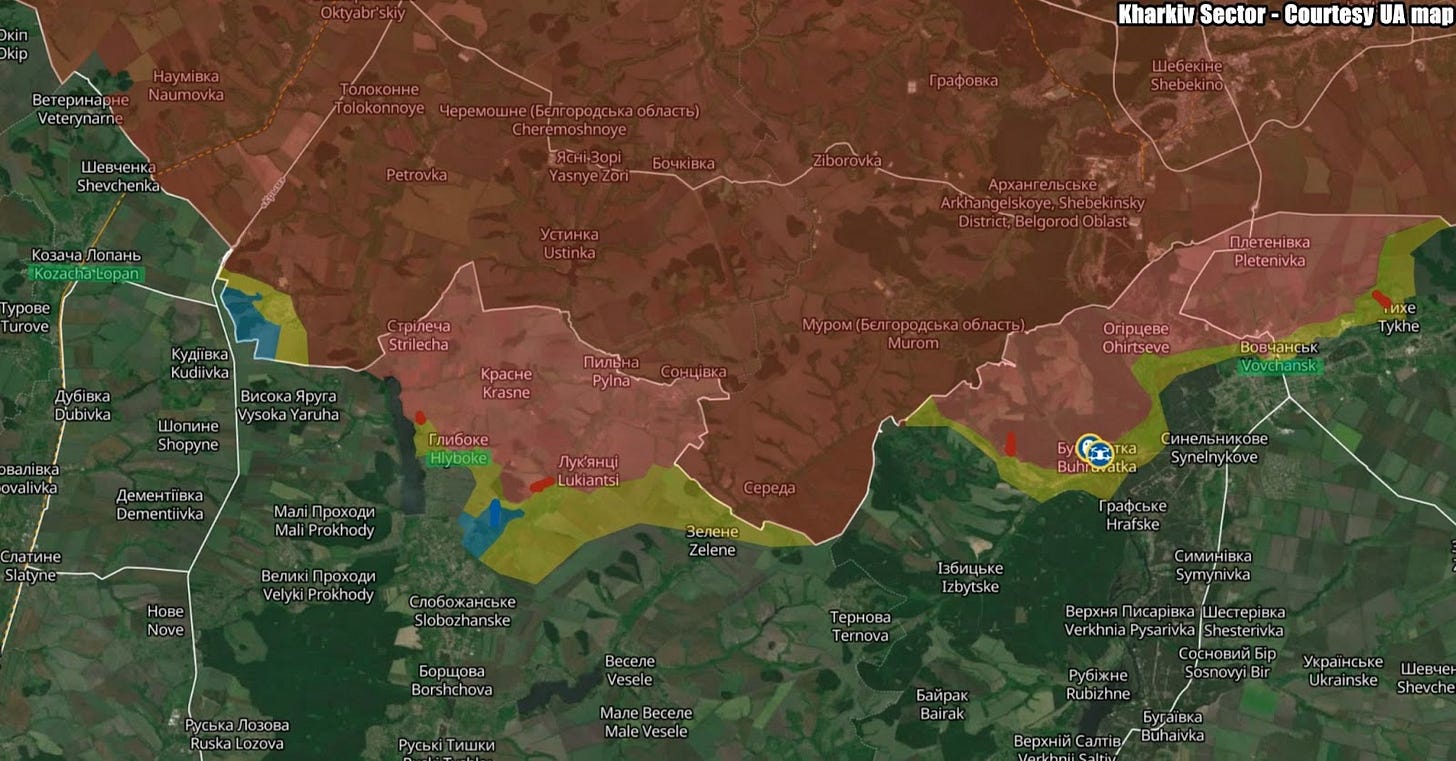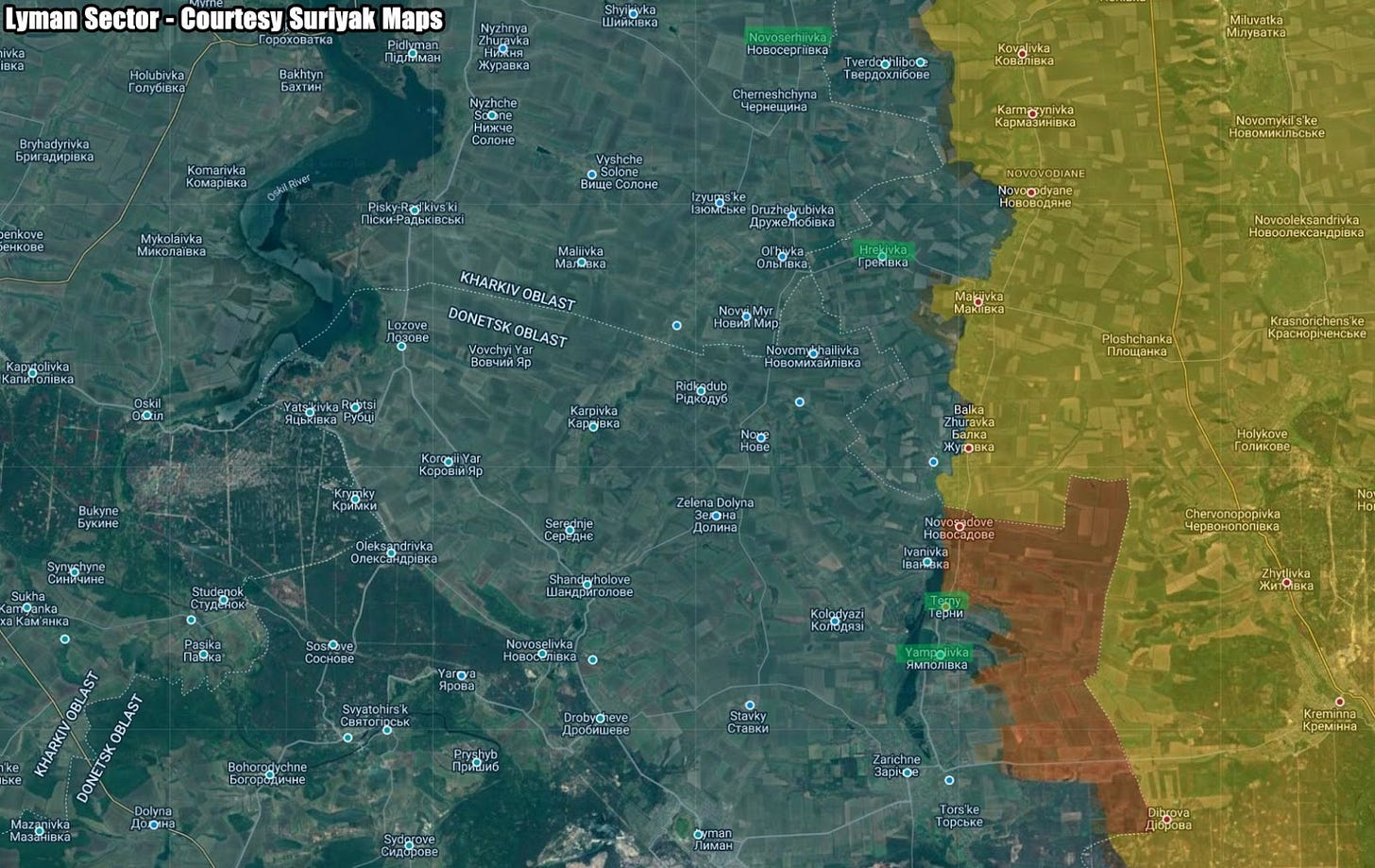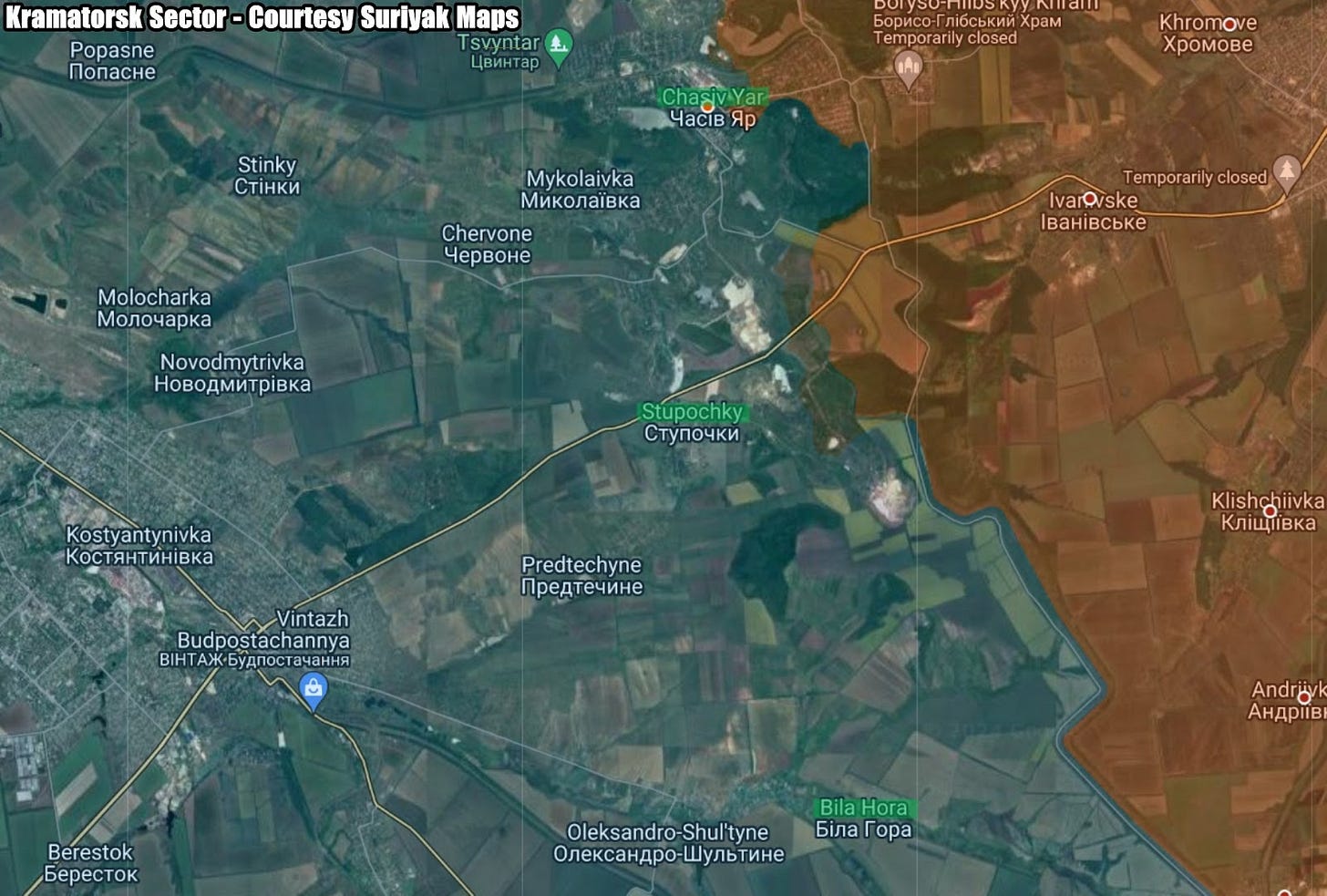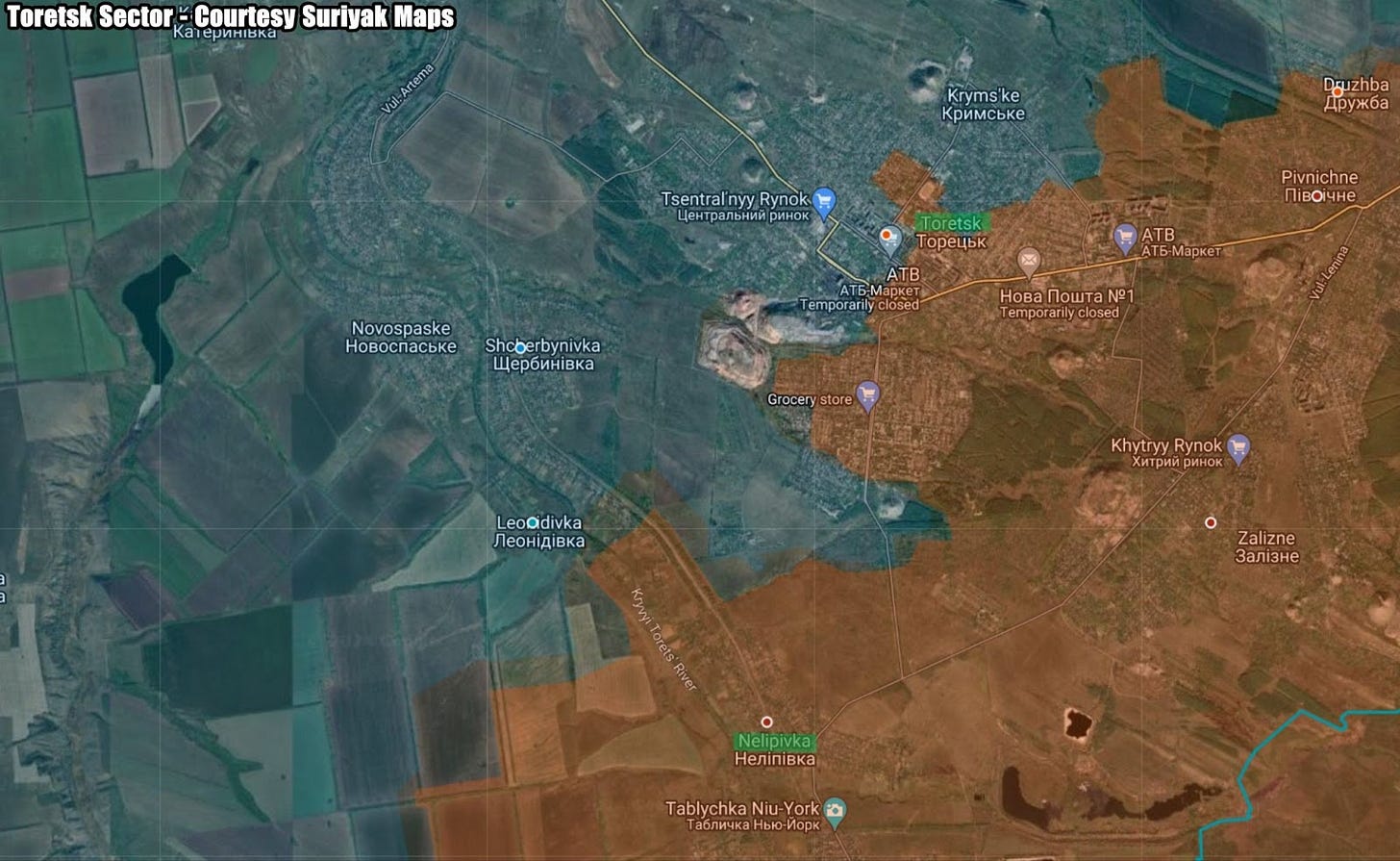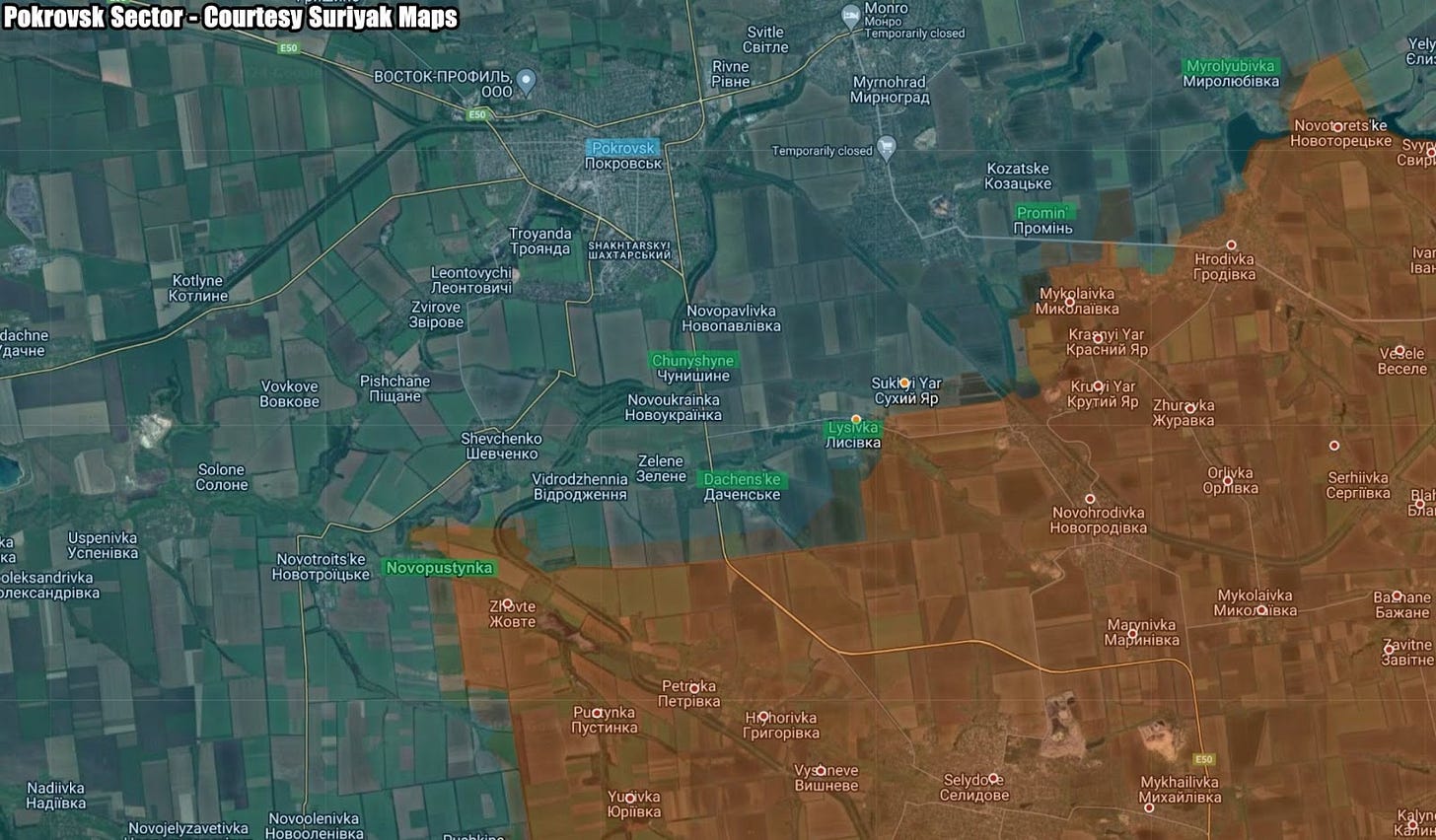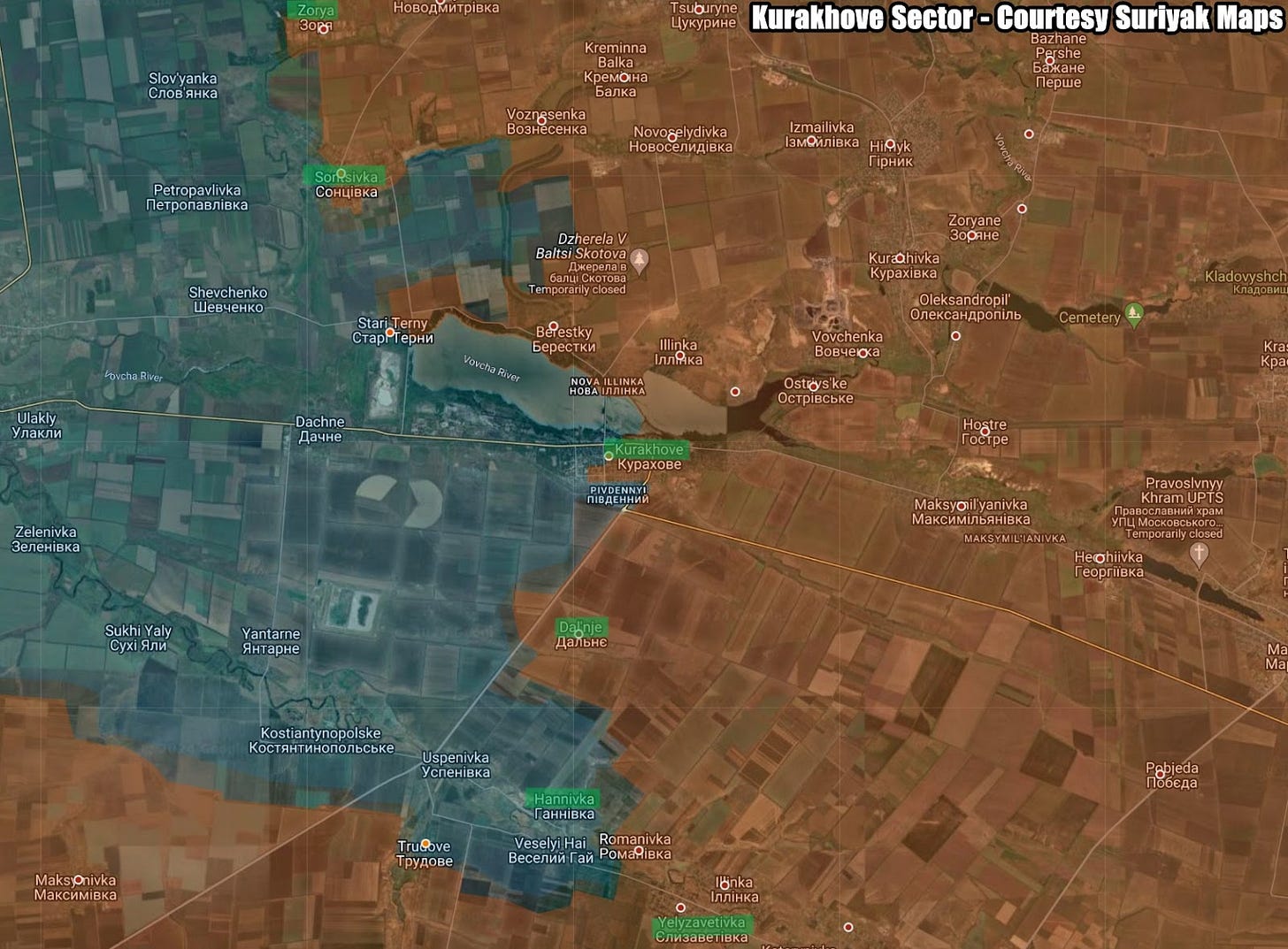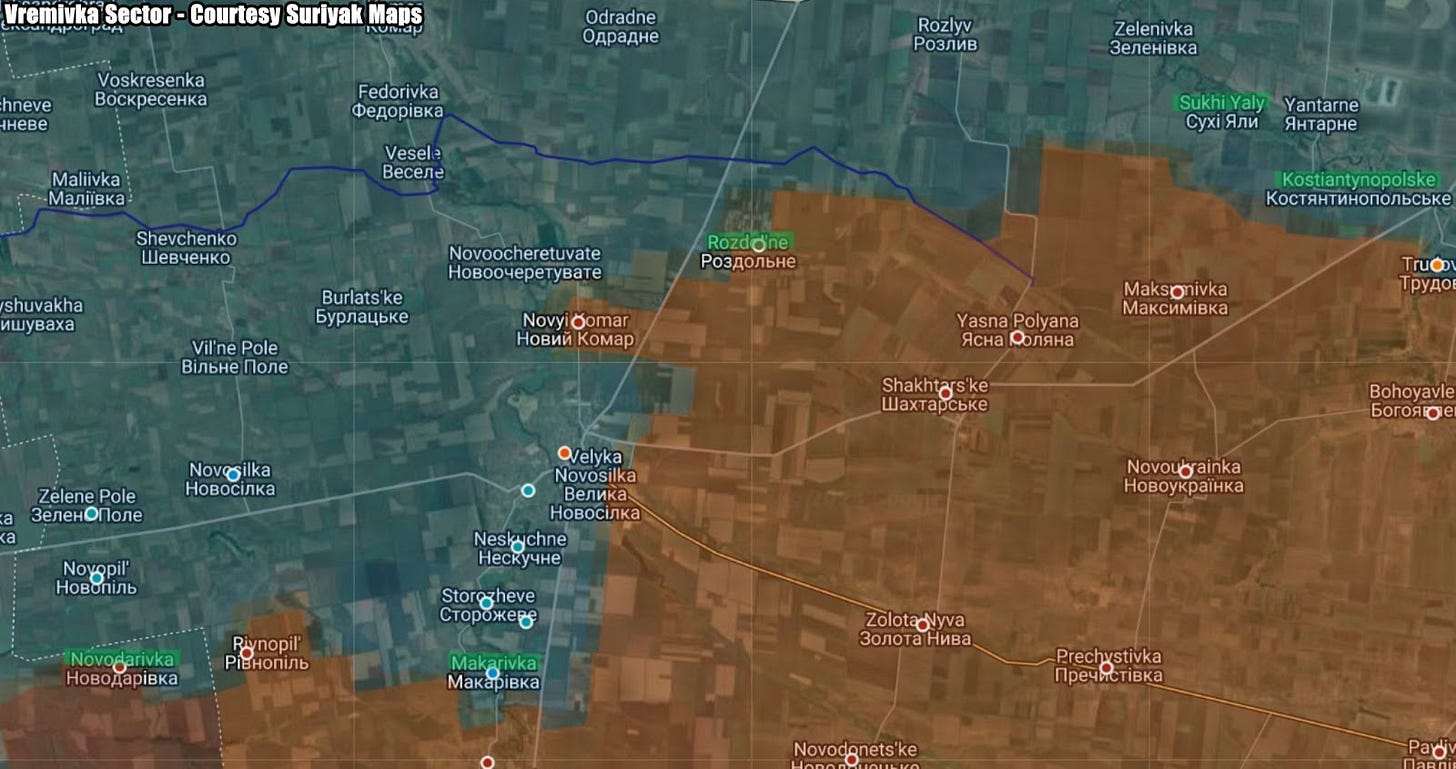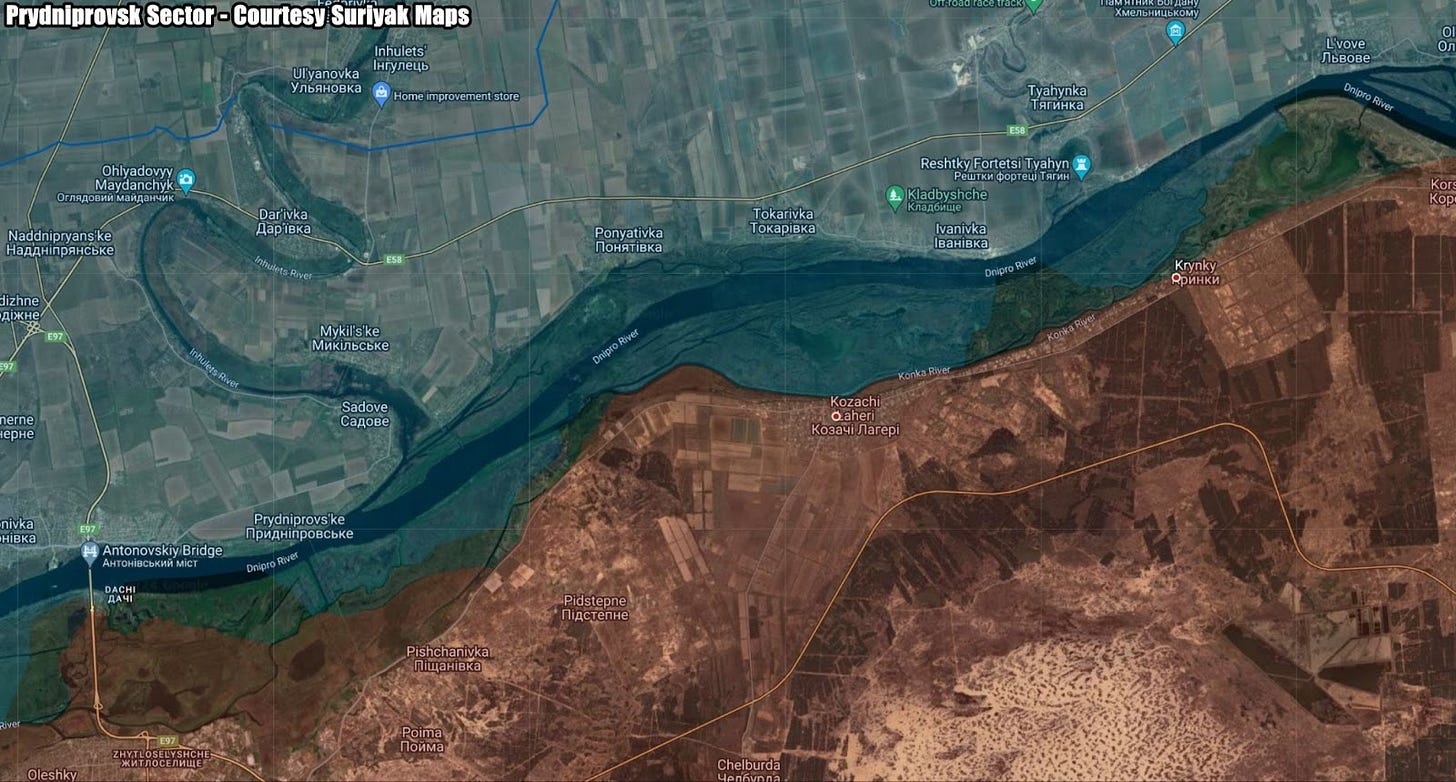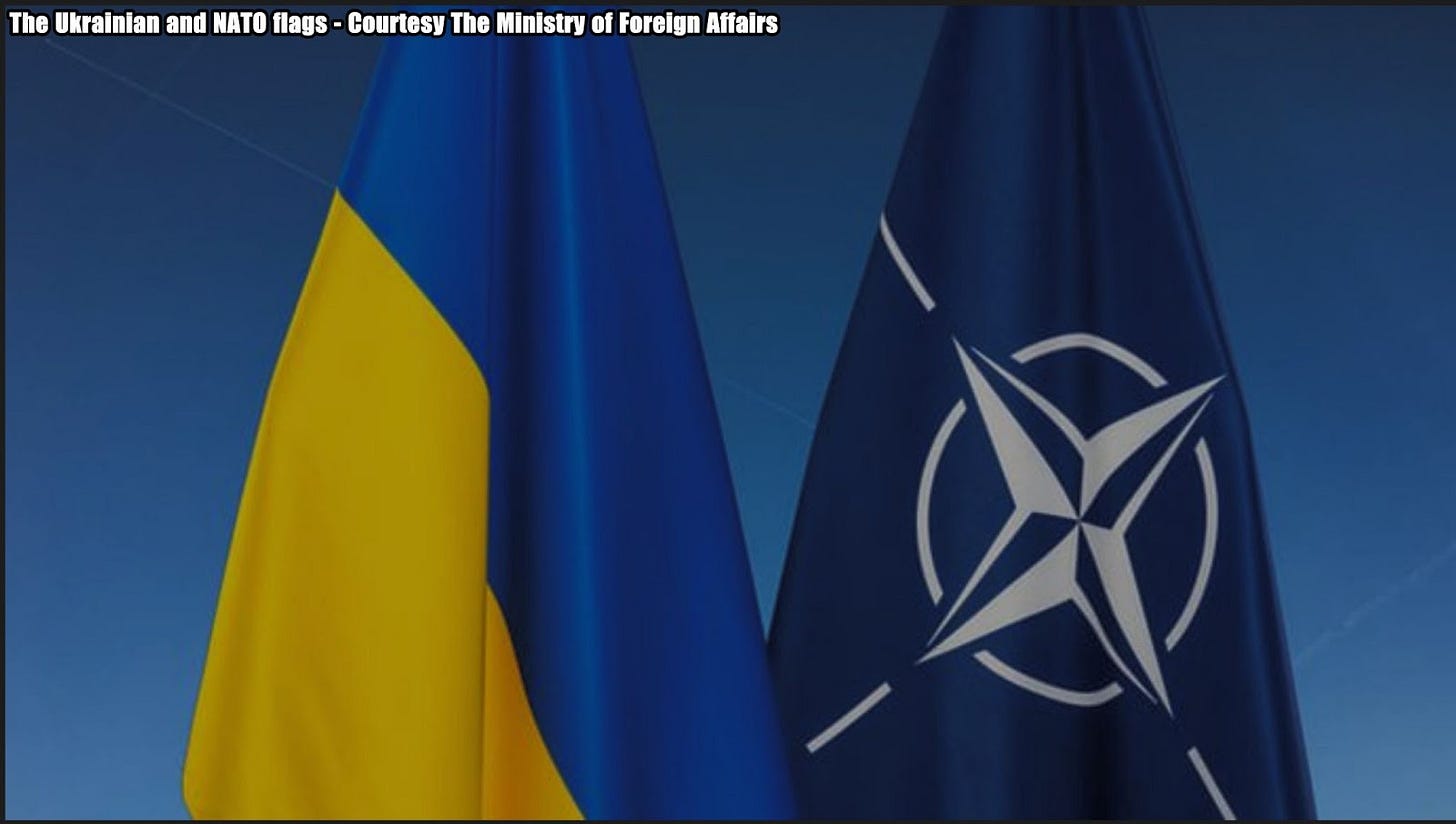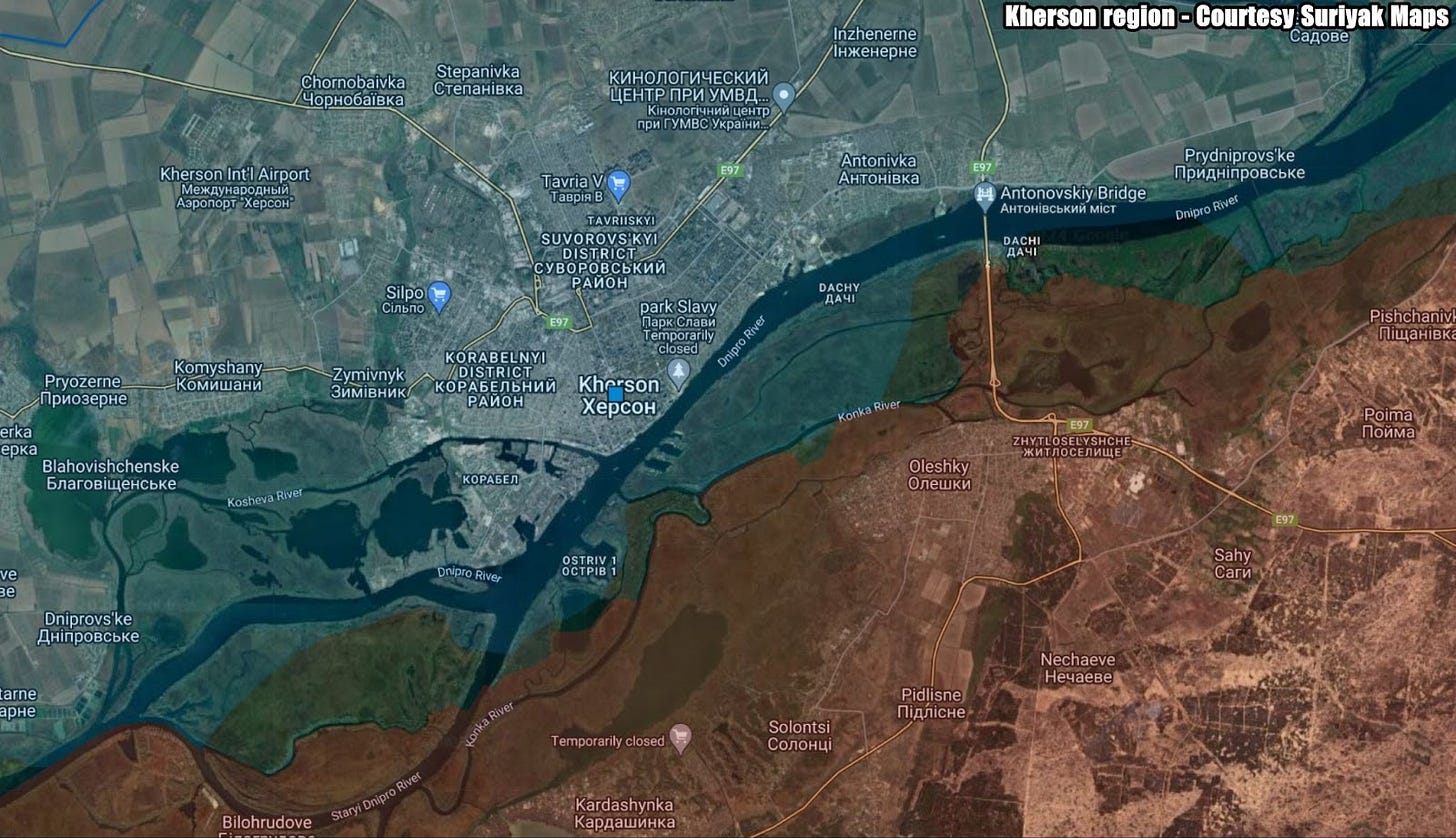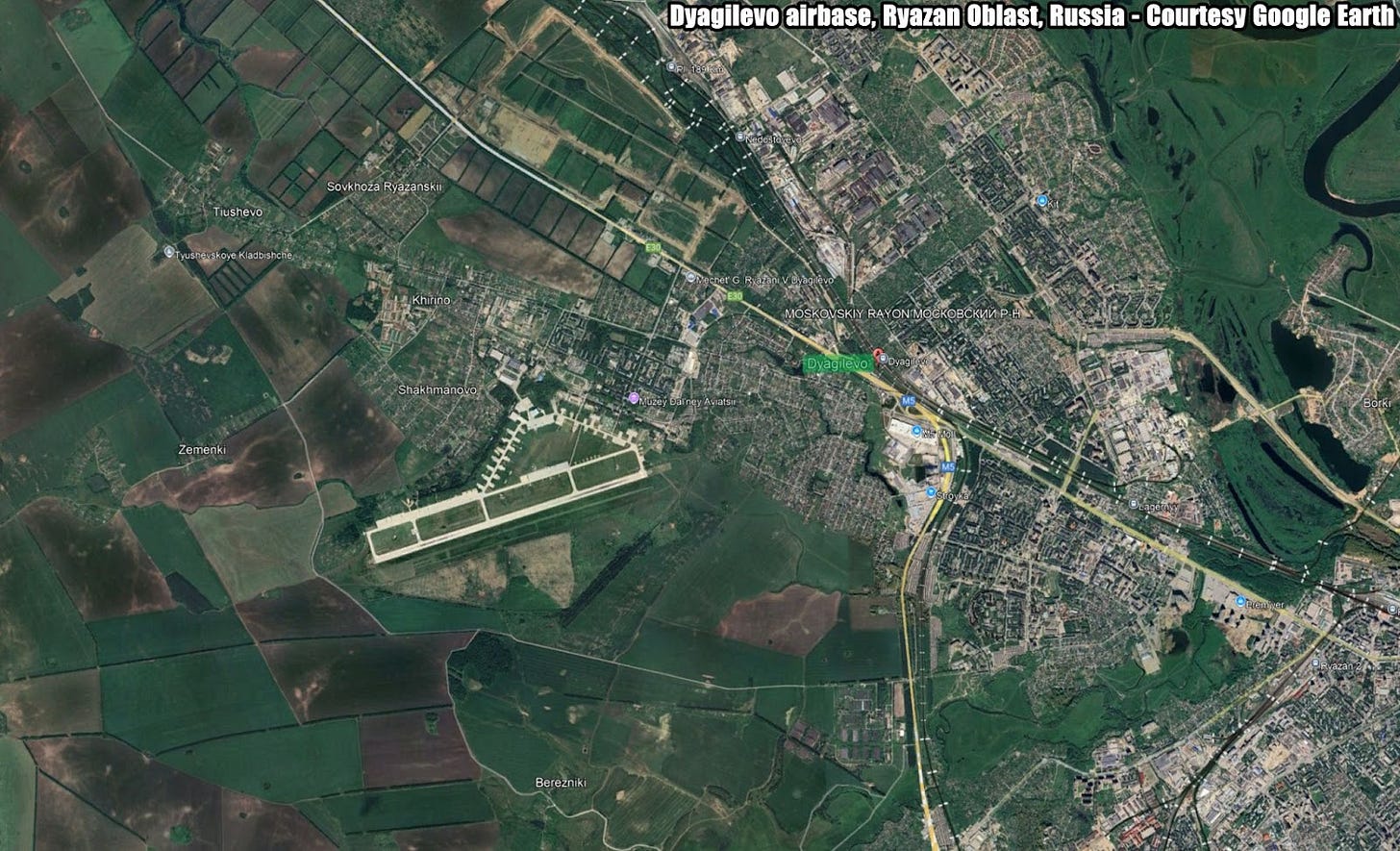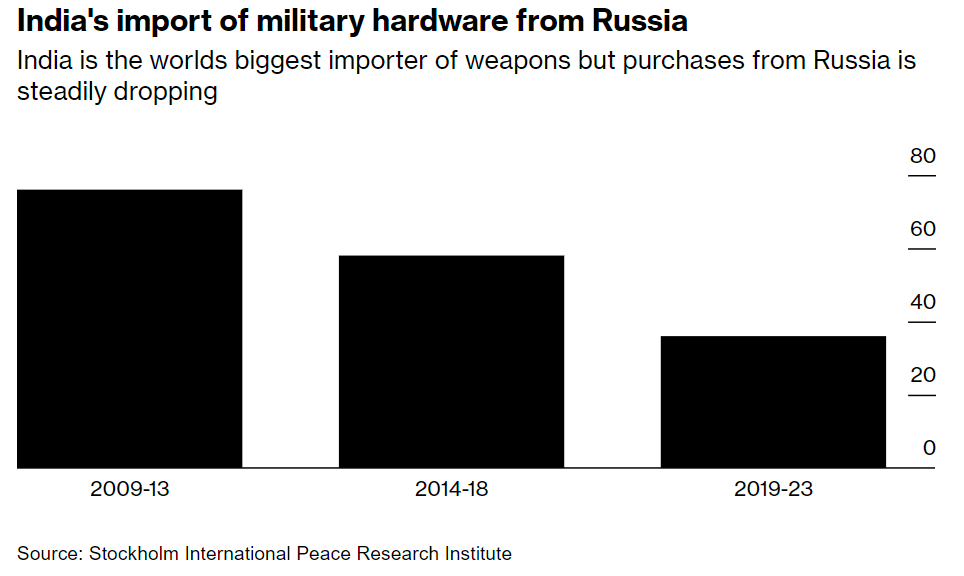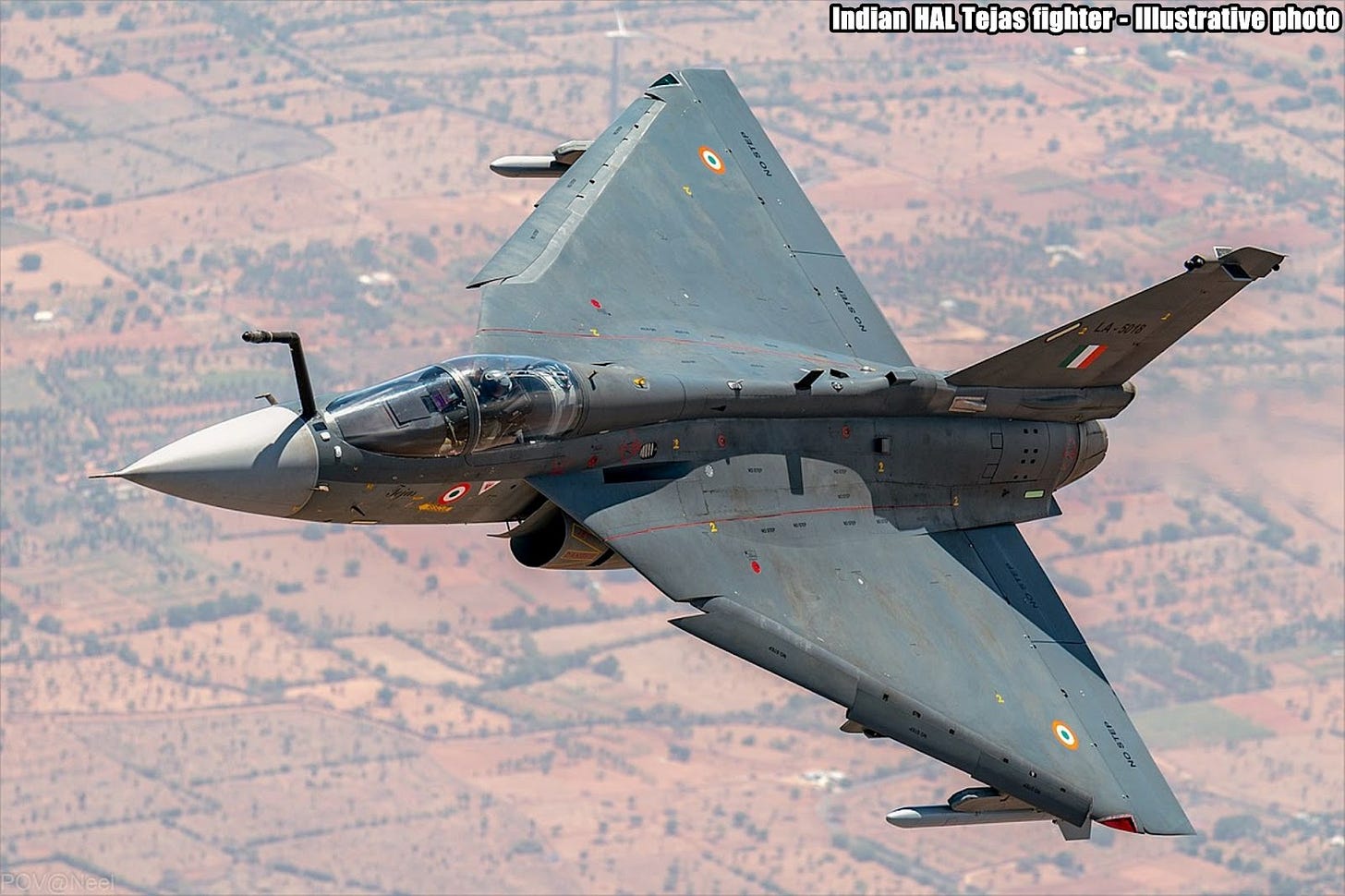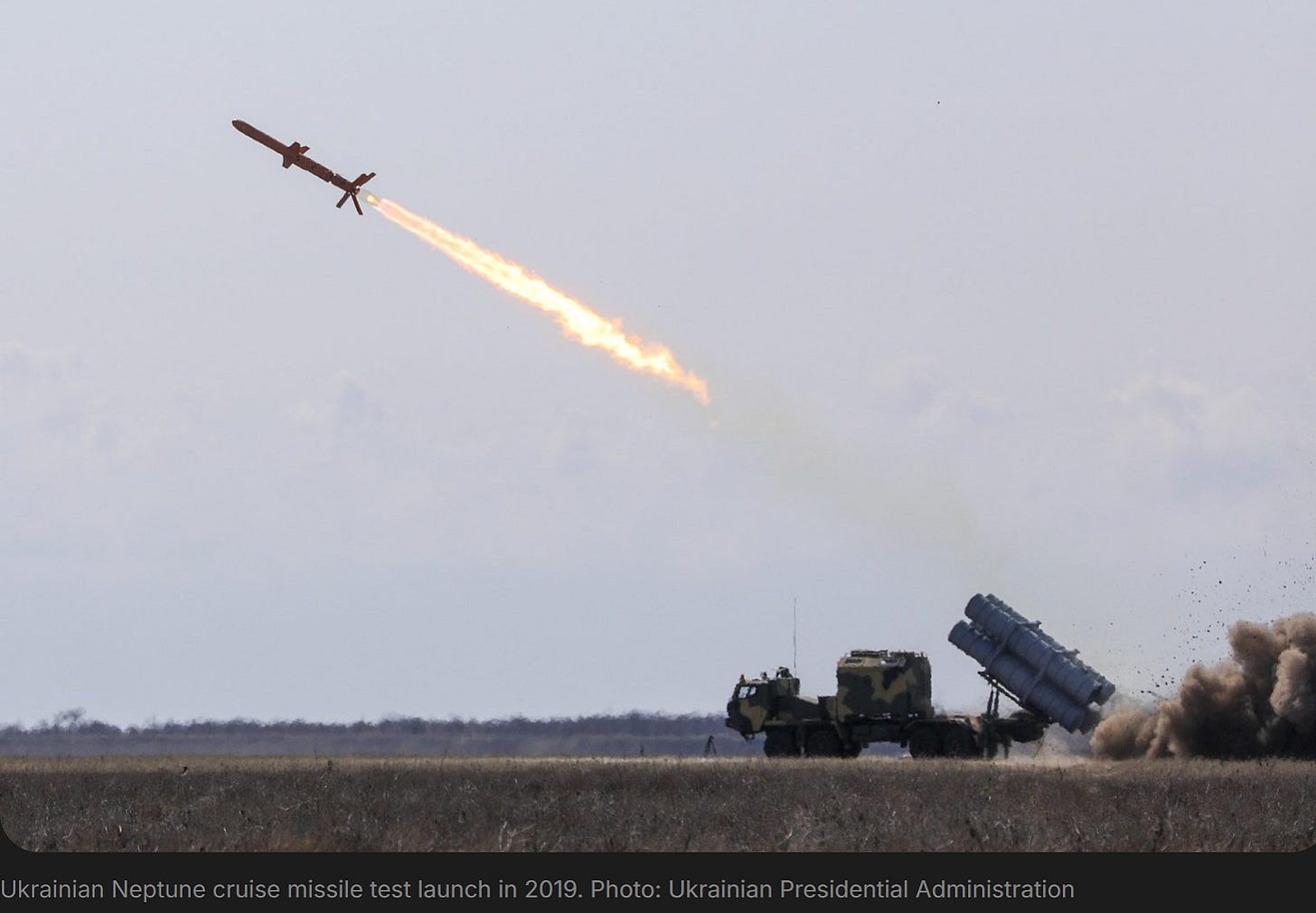Slava Ukraini! In early 2022 I began a Telegram channel aggregating news from a number of sources daily on the war in Ukraine. In June 2023 I began providing a daily draft for the Ukraine War Brief Podcast collecting news from over 70 sources daily, which formed the basis of the script. While the Podcast no longer exists I have continued to make this Brief available for my followers here on Substack for those who wish to keep up with the news from the war. A version of this Brief will also be made available on The People’s Media Substack for those who should choose to subscribe there.
All the latest news on the Russo-Ukraine War 6 days per week
ALONG THE CONTACT LINE
GSAFU Morning Report
GSAFU Morning Report
The General Staff of the Armed Forces of Ukraine in its Operational Information update at 22:00 on Dec 3 stated that day 1015 of the full-scale invasion of the Russian Federation against Ukraine was about to begin.
During the past day, 180 combat engagements took place. Over the past 24 hours, the enemy carried out 42 air strikes, 650 drone strikes and almost 4,000 artillery strikes across the positions of Ukrainian forces.
At the same time, Ukrainian soldiers continue to inflict losses in manpower and equipment on the occupying troops, exhausting the enemy along the entire front line and continue to disrupt the plans of Russian occupiers to advance deeper into the territory of Ukraine.
The Defense Forces of Ukraine continue its operation in Kursk, Ukrainian forces repelled 20 enemy attacks, six more combat clashes are ongoing.
Zelenskyy calls for reinforcement of eastern front against Russian advances
President Volodymyr Zelenskyy called on Tuesday for major reinforcement of sectors in eastern Ukraine of the 1,000-km (600-mile) front line, where Russian forces have made consistent gains in recent months. Reuters reported.
Zelenskyy issued his appeal as Russia's Defence Ministry said its troops had captured two new front-line villages -- one in Donetsk region, the main focus of the 33-month-old war, the other further south in Zaporizhzhia region.
The president was speaking in his nightly video address after a discussion with Ukraine's top commander, Oleksandr Syrskyi. He said much depended on Ukraine's Western allies providing vital weaponry in a timely manner.
"The Donetsk directions require significant reinforcement. This particularly involves the supply of weapons from our partners," Zelenskiy said.
"It's a direct relationship: The greater our army's firepower and technological capabilities, the more we can destroy Russia's offensive potential and protect the lives of our soldiers."
The key, he said, was to boost Ukraine's long-range capabilities, partly by boosting domestic weapons production.
The United States, the biggest supplier of military aid to Ukraine, announced its latest military aid package on Monday, valued at some $725 million. But Ukraine is concerned about the continued flow of weapons under President-elect Donald Trump, who has pledged to put a quick end to the war.
Analysts and war bloggers say that Russian forces in the east are advancing at the fastest rate since the early days of the February 2022 invasion.
Russia's Defence Ministry said its forces had captured the village of Romanivka, south of the embattled town of Kurakhove in Donetsk region. It also said Moscow's forces took control of Novodarivka, just over the border in Zaporizhzhia region.
The Ukrainian military's general staff said Russian forces had launched 38 attacks near Kurakhove, but made no mention of Romanivka. It said nothing about Novodarivka falling into Russian hands, but mentioned the village as one of the areas coming under Russian attack.
Zelenskyy, in a post on his Telegram account, quoted commander Syrskyi as saying conditions were difficult around Kurakhove and Pokrovsk, another target of Russian advances farther north.
But he also spoke of "quite good" results in defending Zaporizhzhia region.
Air defense of the Ground Forces destroyed 193 means of air reconnaissance and attack of the enemy over the past week, namely:
🔸X-101 rocket — 3 units;
🔸 Unmanned aerial vehicle Shahed-131/136 — 124 units;
🔸BpLA Orlan 10/30 — 11 a.m.;
🔸BpLA Zala — 17 units;
🔸Supercam UAV — 7 units;
🔸BpLA "Lancet" — 18 units;
🔸BpLA "Molniya" — 9 units.
🔸 Unmanned aerial vehicle "Privit-82" — 4 units.
Air Force Daily Report
On the night of December 4, 2024 (from 20:00 on December 3), the enemy attacked with a Kh-59/69 guided air missile from the airspace of the Kursk region. and 50 strike UAVs of the "Shahed" type and drones of other types (launch areas - Primorsko-Akhtarsk, Orel, Millerovo - Russian Federation).
As of 09:00, units of anti-aircraft missile forces, EW and mobile fire groups of the Air Force and Defense Forces of Ukraine shot down 29 enemy UAVs in Kyiv, Kharkiv, Poltava, Sumy, Chernihiv, Khmelnytskyi, Ternopil, Mykolaiv and Donetsk regions.
18 drones were lost in location, 1 — left the controlled airspace in the direction of the temporarily occupied territory.
The Russian Border Incursion
The Institute for the Study of War (ISW), a US based think tank, in its Dec 3 Russian Offensive Campaign Assessment reported that Ukrainian forces recently advanced in the main Ukrainian salient in Kursk Oblast amid continued fighting in the area on Dec3. Geolocated footage published on Dec 2 indicates that Ukrainian forces recently advanced in southern Darino (southeast of Korenevo). Russian milbloggers claimed that Russian forces advanced in Novoivanovka (southeast of Korenevo) and near Malaya Loknya (north of Sudzha). ISW has not observed confirmation of these claims, however.
Russian sources claimed that Ukrainian forces unsuccessfully counterattacked near Darino, Nikolayevo-Darino (southeast of Korenevo), Novoivanovka, and Pogrebki (northwest of Sudzha). The commander of a Ukrainian unit operating in Kursk Oblast reported on Dec 3 that Russian forces are struggling to supply frontline units, transport armored vehicles to the frontline, and accumulate forces for large-scale attacks due to poor logistical support. Elements of the Russian 106th Airborne (VDV) Division are reportedly operating in Kursk Oblast, and elements of the Chechen "Akhmat" Spetsnaz are reportedly operating in the Sudzha direction.
The Khortytsia operational-strategic group
(Responsible for the northeastern part of Ukraine. )
Kharkiv Sector: Over the last day Ukrainian Defense Forces repelled 6 Russian attacks in the area of Kozacha Lopan, Hlyboke and Vovchansk.
Kupyansk Sector: Russian Forces carried out 16 offensive actions against Ukrainian defensive positions near Kolisynivka, Lozova and Pershotravneve. 6 engagements are ongoing.
Lyman Sector: Russian Forces carried out 9 offensive actions against Ukrainian defensive positions near Novoserhiivka, Hrekivka, Terny and Yampolivka.
Siversk Sector: In this sector, over the last day, there has been no significant change in the combat environment.
Kramatorsk Sector: Russian forces carried out 3 offensive actions against Ukrainian defences in the vicinity of Chasiv Yar, Stupochky and Bila Hora.
Toretsk Sector: Over the last day Russian forces carried out 3 offensive actions with air support near Toretsk and Nelipivka.
The Tavria operational-strategic group
(Responsible for the central-eastern and southeastern part of Ukraine.)
Pokrovsk Sector : Over the last day in this sector, Russian Forces carried out 44 offensive actions against Ukrainian defensive positions in the vicinity of Myrolyubivka, Promin, Chunyshyne, Lysivka, Dachenske and Novopustynka . 6 engagements are ongoing.
Kurakhove Sector: Russia conducted 38 offensive actions in the vicinity of Zorya, Sontsivka, Kurakhove, Dalnje, Hannivka, and Yelyzavetivka. 4 engagements are ongoing.
Vremivka Sector: Russian forces made 23 attempts to break through Ukrainian defences in the vicinity of Novopil, Novodarivka, Rozdolne, Makarivka, Sukhi Yaly, and Kostiantynopolske. 6 engagements are ongoing.
Orikhiv Sector: Russian forces made 4 attempts to break through Ukrainian defences in the vicinity of Novodanilívka, Novoandriivka and Robotyne.
The Odesa operational-strategic group
(Responsible for Kherson, Qırım, (also known as Crimea) and the Black Sea.)
Prydniprovsk Sector: In this sector, over the last day, there has been no significant change in the combat environment. Russian forces made 5 unsuccessful attempts to dislodge Ukrainian units from their positions.
TEMPORARILY OCCUPIED TERRITORIES
Nothing major to report.
THE HOME FRONT
NATO's assessment of Ukraine's annual reform plan is positive, Foreign Ministry says
Ukraine's Foreign Minister Andrii Sybiha has announced that he has received NATO's assessment of Ukraine's implementation of the NATO-Ukraine Annual National Programme (ANP). Ukrainska Pravda reports.
Sybiha said that receiving the Alliance's opinion on the ANP was the official reason for the NATO-Ukraine Council meeting: "The purpose of this meeting was to assess Ukraine's progress in implementing the Annual National Programme." He said the Alliance's conclusion was positive.
"We’ve received a positive assessment of the ANP implementation. Our progress towards the unchanging strategic goal of Ukraine's accession to NATO has been assessed positively. And this is very important," he stated, but gave no other details.
The ANP is the key tool with which NATO assesses Ukraine. The successful implementation of annual programmes is one of the criteria for inviting Ukraine to join.
Russia uses civilians as “target practice” for killer drones.
There is little more comforting to the people of Kherson these days than the sight of bad weather. When clouds gather, rain pours and winds sweep through this southern Ukrainian city, locals take their cue to run errands — sensing a pause, at least temporarily, in the terror that has filled their skies.
Kherson’s civilians have been, since midsummer, the target of an experiment without precedent in modern European warfare: a concerted Russian campaign to empty a city by stalking its residents with attack drones. The Financial Times reports.
The killer machines, sometimes by the swarm, hover above homes, buzz into buildings and chase people down streets in their cars, riding bicycles or simply on foot. The targets are not soldiers, or tanks, but civilian life.
“They are hunting us,” said Oleksandr Prokudin, head of the Kherson regional military administration. “Imagine what that does to a person, the psychological impact.”
Since mid-July, Kherson and its neighbouring villages along the western side of the Dnipro river have suffered more than 9,500 attacks with small drones, killing at least 37 people and injuring hundreds more, according to Prokudin, regional prosecutors and police.
Prokudin told the Financial Times that Russia had deployed some of its “best drone units” across the Dnipro river, which bisects Kherson and serves as the front line. From the bank opposite the city centre, he said, the Russians were launching advanced drone models, refining combat techniques and training new operators for their intensifying invasion.
Scores of videos of drone attacks on civilians are posted on Russian military and pro-war Telegram channels. The Eyes on Russia project by the Centre for Information Resilience (CIR), a London-based non-profit focused on exposing human rights abuses and war crimes, analysed and verified 90 of them in a new report — a video catalogue of the drone onslaught.
Ukrainian officials suspect the assault is part of Russia’s plan to ratchet up pressure on Kyiv before Donald Trump returns to the White House, accelerating battlefield gains and preparing for a potential push across the Dnipro river.
“Russia wants to launch another offensive here,” said Prokudin, adding that Russian forces had assembled “300 boats to cross the river”.
Serhiy Bratchuk, a spokesperson for the Ukrainian volunteer army’s southern forces, said Russian troops were trying to seize the river islands and move closer to Kherson’s western bank. They had recently conducted a large attack on Kozatskyi island north-east of the city, near Nova Kakhovka.
The drone attacks have accelerated a civilian exodus from the area. Kherson region’s 1mn population has plummeted to just 158,000 since Russia’s invasion. Kherson city had 250,000 residents; today, there are just 60,000.
Tetyana Aksenchuk, a 49-year-old resident of the neighbouring Veletenske village, said drones circled homes and people “like birds”. Sometimes five of them at once, armed with explosives, will loiter over apartment buildings, businesses and public places where people gather, waiting to spot a target. “If they see any movement, they immediately attack,” she said.
The Russian drones can also carry incendiary bombs, which set fires to homes and fields. The wind from the river valley fuels the flames, which jump from building to building.
Aksenchuk was badly injured after she rushed to put out the fires from a co-ordinated drone and rocket attack; two of the three ambulances that came to treat her were then ripped apart by another swarm of bomb-carrying drones.
Several medics were injured and one driver was killed. “I watched this,” said Aksenchuk. “He was sitting behind the wheel and burning.”
RUSSIAN WORLD
Ukrainian drones allegedly strike Russia's Ryazan Oblast, explosions reported near airbase
Russian authorities claimed Ukrainian drones attacked Ryazan Oblast overnight on Dec. 4, with Telegram channels reporting explosions in the area of the Dyagilevo airbase. The Kyiv Independent reports.
At least four drones were shot down over the western Russian region overnight, Governor Pavel Malkov claimed.
"At the crash site of a downed drone in the Korablinsky district, windows of four nearby houses were damaged. There were no casualties," Malkov claimed. The Korablinsky district lies roughly 60 kilometers (around 40 miles) south of the regional center, Ryazan.
Russia's Defense Ministry reported destroying 35 Ukrainian drones across multiple regions, including four over Ryazan Oblast.
The Russian news channel Astra wrote that Ryazan residents heard explosions near the Dyagilevo airbase on the city's outskirts. There have been no official comments on the situation in the regional center or the airbase.
Kyiv has not commented on the claims, which could not be independently verified.
The Dyagilevo airbase, lying almost 500 kilometers (300 miles) from the Ukrainian border, reportedly hosts the 43rd Center for Combat Training with Tu-22M3, Tu-95MS, Tu-134UBL, and An-26 aircraft, as well as Il-78 tanker planes and a repair plant.
A Ukrainian drone is said to have struck the airbase in December 2022, killing and injuring several soldiers. The military facility was allegedly targeted again in July 2024.
Kyiv's forces have been launching drone attacks ever deeper into Russian territory, targeting military bases and industrial facilities to undermine Moscow's war effort in Ukraine.
Grumpy Here - Below is a photo of Dyagilevo airbase from Google Earth taken this year, aircraft can clearly be seen parked in the open on the tarmac.
Russia’s Central Bank Governor Says Likely Rate Hike ’Not Predetermined’
Russia’s Central Bank Governor Elvira Nabiullina said Wednesday the bank would likely raise the key interest rate this month, but the decision is not predetermined due to a recent slowdown in loans. The Moscow Times reports.
The regulator raised its key rate to a record-high 21% in October and said there was a “very high probability” of another increase at its Dec. 20 meeting.
“We’ve signaled that the Central Bank allows for the possibility of raising the rate, but I want to emphasize that it’s not predetermined,” Nabiullina said at an investment conference organized by Russia’s second-largest bank VTB.
She acknowledged a “new pro-inflationary factor” of the weakening ruble, which lost 15% of its value against the dollar last month. But she said its impact could be offset by a recent slowdown in lending.
“Of course we’ll take this factor into account, we’ll get more new data before the board meeting,” Nabiullina said at the conference.
VTB CEO Andrei Kostin said this week that the Central Bank’s tight monetary policy has reduced its loan portfolio and profit expectations.
“The slowdown in corporate and general lending will be followed by a slowdown in the money supply, which will eventually have a lagging effect on inflation,” Nabiullina said. “We’ll also take these lags into account.” Nabiullina said she expects inflation to slow down in 2025 and reach the bank’s target rate of 4% in 2026.
INTERNATIONAL NEWS
India Pivots From Russia to US for Cutting-Edge Weapons.
India has sharply reduced orders for defense equipment with Russia and is now buying more from Western suppliers, officials said, a significant policy shift for a nation traditionally reliant on arms from Moscow. Bloomberg reports.
India and Russia’s plans to jointly develop and manufacture helicopters and advanced fighter jets were shelved some time ago, according to senior Indian officials with direct knowledge, who asked not to be identified because the discussions are private.
A separate proposal to lease a nuclear-powered submarine from Russia to train Indian crew is also unlikely to move forward, they said, noting that the South Asian nation is building its own vessels. Two warships and batteries for an anti-missile shield, which were ordered prior to the war in Ukraine, are the only outstanding items New Delhi has yet to receive from Moscow.
India’s ministries of defense and external affairs didn’t reply to requests for comment.
India, the world’s biggest importer of weapons, has been buying less and less from Russia. Only 36% of India’s arms imports came from Russia last year, down from 76% in 2009, according to a March report from the Stockholm International Peace Research Institute, an independent think tank that studies conflict, weapon sales and disarmament.
India’s move to wean itself off Russian weapons underscores Prime Minister Narendra Modi’s efforts to steadily reduce its dependence on Moscow, even as his government continues to buy cheap energy from Russia and provide diplomatic support to Vladimir Putin. India at the same time has moved closer into the US defense orbit, providing an anchor for the relationship just as Donald Trump comes into office threatening higher tariffs.
New Delhi’s shift from Russia has helped US-based suppliers. According to the SIPRI, India is now buying more from Western companies and trying to build homemade weapons with support from the US and France. Over the past two decades, Washington has eased restrictions barring developing countries from accessing advanced technology.
Since 2018, India has inked contracts worth nearly $20 billion for US-made products, according to a report from the US Congressional Research Service. In October, the South Asian country green-lit a more than $3 billion deal for 31 long-range drones made by US defense giant General Atomics.
India’s state-owned Hindustan Aeronautics Ltd. and General Electric Co. are also close to signing an agreement to jointly manufacture an advanced version of jet engines for the next generation of light-combat aircraft, according to Indian officials who asked not to be named as discussions are private. The authorities agreed on terms of the partnership during Modi’s state visit to the US last year.
Russian-made weapons are often cheaper than Western ones. But they need frequent repairs, which affects their desirability and makes them costlier in the long run, said another senior Indian official, who asked not to be named to discuss sensitive information.
“India has slowly shifted to Western-origin platforms because the military is increasingly comfortable with such technology,” said Anit Mukherjee, a senior lecturer at King’s College London who specializes in India’s military and foreign policy.
The pivot away from Moscow is a defining feature of Modi’s foreign policy. It underscores India’s efforts to balance ties with Russia, which sells cheap oil to New Delhi, and the US, which is helping ramp up defense manufacturing and add jobs in the South Asian nation.
The war in Ukraine has accelerated India’s reduction in buying Russian weapons. A delay in supplying anti-missile shields is proof of Russia’s strained capacity, said Sushant Singh, a lecturer of South Asian studies at Yale University.
Russia’s ties with China have also further complicated the equation. “Russian defense industries’ reliance on Chinese electronics is problematic and a red flag for India,” said Mukherjee.
Even so, New Delhi and Moscow are jointly manufacturing rifles and missiles in India, and Russia still remains the South Asian nation’s largest supplier of military hardware. The bulk of imports, however, comprises spare parts to keep legacy equipment functional. That includes everything from basic rifles to army tanks and India’s primary fighter jet.
“These will remain in service for decades and India will need spare parts and ammunition from Russia for a long time,” said Singh.
New Delhi’s fighter fleet is dropping steadily as it faces off against two hostile neighbors — China and Pakistan. It may need help from Moscow there too: India’s homemade fighters program stalled after US-based GE failed to supply jet engines.
In addition, India continues to be dependent on Russia for nuclear capabilities.
“Russia remains the only country which offers its nuclear submarines to India,” said Mukherjee. “India’s partnership with Western countries will be incomplete until both sides find a way to talk about nuclear issues.”
MILITARY & TECH
Ukraine to increase missile production, Zelenskyy says after successful tests
On 3 December, Ukrainian President Volodymyr Zelenskyy confirmed the acceleration of Ukraine’s missile production as part of a broader effort to meet the growing demands of the ongoing Russian invasion of Ukraine. In a statement shared via his official Telegram channel, Zelenskyy highlighted the key focus areas of Ukraine’s defense industry, which are now centered around FPV (first-person-view) drones, reconnaissance drones, long-range drones, and missile systems. Euromaidan Press reports.
Amid limited missile supplies from Western partners, Ukraine is advancing its own missile programs. In mid-November, Zelenskyy instructed domestic manufacturers to produce at least 3,000 missiles and 30,000 long-range drones to bolster Ukraine’s military capabilities in the Russo-Ukrainian war. Ukraine’s Defense Minister, Rustem Umierov, reported in September that negotiations with allies had begun to secure direct funding for the missile program.
Reporting on today’s meeting of the Stavka (HQ) of Ukraine’s Supreme Commander-in-Chief, President Zelenskyy emphasized the acceleration of defense production capabilities. The Supreme Commander-in-Chief is one of President Zelenskyy’s official roles.
The main topic were reports on contracts for our weapons production in Ukraine,” he said. “There is a significant volume of new and long-term orders for drones: FPV drones, reconnaissance drones, long-range drones, and drone-missiles.”
The President did not provide further details on the specific missile models currently in production or development.
However, it is known that Ukraine produces Neptune cruise missiles in limited quantities – originally designed as anti-ship weapons, they have since been adapted for ground attack. The Hrim-2 short-range ballistic missile system is also under development, with previous reports indicating successful flight tests, and potentially more live-fire tests to follow.
Additionally, Ukraine manufactures the Stugna-P anti-tank guided missile, though it is likely not a focus of Zelenskyy’s statement. There have also been reports of a medium-range anti-air missile program in development, alongside the possibility of other classified missile projects.
In addition to the missile and drone advancements, discussions also covered artillery production contracts, the Ukrainian President noted.
Finally, Zelenskyy reported holding a separate meeting with the Prime Minister, the Minister of Energy, and the Commander of the Ukrainian Air Force to discuss the protection of energy infrastructure and ongoing recovery efforts. Ukraine’s Air Force also oversees the country’s Air Defense Forces.
Ukraine's new Palianytsia missile-drone enters serial production, minister says.
Ukraine’s recently developed Palianytsia, a lightweight missile-drone hybrid, has entered serial production, Defense Minister Rustem Umerov wrote in an op-ed on Dec. 4. The Kyiv Independent reports.
"A new start-up implemented the Palianytsia missile project, which has already entered serial production thanks to the support of the Defense Ministry," Umerov wrote in the article published by the LB.UA outlet.
Ukraine began actively developing its missile program after Russia's full-scale invasion in February 2022.
Domestically produced long-range weapons are of key importance to Ukraine's defense strategy, as Western partners only recently allowed strikes in Russia’s Kursk Oblast with foreign-made missiles but prohibited attacks deeper in the rear.
One of these domestic-made weapons is the missile-drone hybrid named Palianytsia, which combines existing technologies to effectively strike deep into Russian territory.
"The use of foreign missiles often requires coordination with partners… Ukrainian cruise and ballistic missiles will allow our Armed Forces to act independently, delivering pinpoint strikes on key enemy targets," Umerov wrote.
President Volodymyr Zelenskyy announced in November that Ukraine has produced its first 100 missiles. According to Umerov, Ukraine also resumed and scaled up serial production of Neptune cruise missiles, modifying them to have a greater range.
There is a "significant volume" of new and long-term orders for first-person-view (FPV) drones, reconnaissance drones, long-range drones, and missile-drones, Zelensky said on Dec. 3 after a meeting with top officials.
That’s it for today’s Brief folks if you would like to keep up with events in Ukraine daily please consider subscribing.
Feel free to share this update with your friends. Heroyam Slava!







